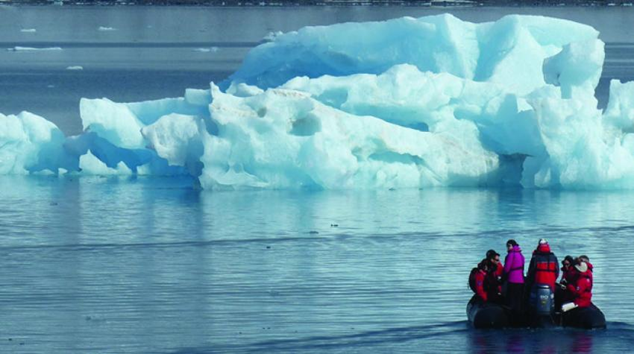- Courses
- GS Full Course 1 Year
- GS Full Course 2 Year
- GS Full Course 3 Year
- GS Full Course Till Selection
- Online Program
- GS Recorded Course
- NCERT (Recorded 500+ Hours)
- Polity Recorded Course
- Geography Recorded Course
- Economy Recorded Course
- AMAC Recorded Course
- Modern India, Post Independence & World History
- Environment Recoded Course
- Governance Recoded Course
- Science & Tech. Recoded Course
- International Relations and Internal Security Recorded Course
- Disaster Management Module Course
- Ethics Recoded Course
- Essay Recoded Course
- Current Affairs Recoded Course
- CSAT
- 5 LAYERED ARJUNA Mentorship
- Public Administration Optional
- ABOUT US
- OUR TOPPERS
- TEST SERIES
- FREE STUDY MATERIAL
- VIDEOS
- CONTACT US
Can the Oceans Turn the Tide in the Fight Against Climate Change?
Can the Oceans Turn the Tide in the Fight Against Climate Change?

- The ocean, often referred to as Earth's "blue lung," has played an important yet often underappreciated role in regulating the planet’s climate. For decades, it has:
- Absorbed 25% of anthropogenic carbon dioxide emissions.
- Taken in over 90% of the excess heat caused by greenhouse gases.
- These processes have helped buy humanity critical time by mitigating some of the worst effects of climate change.
- However, the ocean’s capacity to absorb carbon and heat is not without consequences:
- Ocean acidification threatens marine organisms, especially those with calcium carbonate shells, like coral reefs and shellfish.
- Ocean acidification refers to the process by which the ocean becomes more acidic due to the increased amount of carbon dioxide (CO2) in the atmosphere.
- When CO2 is absorbed by seawater, it reacts with water to form carbonic acid.
- This acid dissociates into hydrogen ions and bicarbonate ions, increasing the overall acidity of the water.
- Warming oceans alter currents and can cause marine habitats to lose oxygen, affecting biodiversity.
- These disturbances have cascading effects on ecosystems, impacting services such as fisheries and carbon sequestration.
- Ocean acidification threatens marine organisms, especially those with calcium carbonate shells, like coral reefs and shellfish.
- While the ocean continues to absorb carbon, it does so at a slow pace and with long-term ecological costs.
A New Approach: Marine Carbon Dioxide Removal (mCDR):
Marine Carbon Dioxide Removal (mCDR) refers to a set of techniques that aim to remove carbon dioxide (CO2) from the atmosphere by using the ocean. The idea is to capture the ocean's natural processes or create new ways to capture and store CO2 in marine ecosystems to help mitigate climate change.
- As the world faces the dual challenges of reducing carbon emissions and building resilience to climate change, marine carbon dioxide removal (mCDR) has emerged as a potential solution to complement emissions reductions.
- The concept is rooted in leveraging the vast, largely untapped potential of marine ecosystems to absorb excess carbon from the atmosphere.
- Unlike land-based carbon capture, marine environments such as oceans, seas, rivers, and lakes offer unique solutions.
- Key points include:
- Deep water bodies can remove excess carbon quickly, transporting it into deeper ocean layers where it is bound with minerals.
- On land, soils and rocks are nearing saturation and no longer support efficient carbon capture, but the ocean still holds untapped capacity for this purpose.
Types of Marine Carbon Capture Strategies:
-
Biotic Approaches (Nature-Based Solutions):
- These rely on living ecosystems like mangroves, macroalgae, and even river systems to sequester carbon.
- They also promote biodiversity conservation and coastal protection.
- While well-established, biotic solutions have limited capacity for carbon sequestration (less than 1 billion tonnes of CO2 per year) and relatively short-term storage (hundreds to thousands of years).
-
Abiotic Approaches (Engineered Solutions):
- These focus on physical or chemical interventions, such as ocean alkalinity enhancement (OAE), which involves adding alkaline materials to neutralize ocean acidification.
- Abiotic techniques are scalable and have much higher potential.
- For example, biomass burial at sea could sequester 7 to 22 billion tonnes of CO2 annually, while OAE could sequester 1 to 15 billion tonnes annually.
- These approaches offer long-term storage (tens of thousands of years), but they come with greater complexity, higher energy requirements, and the potential for unforeseen ecological impacts.
The Scale of the Climate Challenge
- To keep global warming below 1.5°C compared to pre-industrial levels, global carbon emissions need to be capped at 570 billion tonnes of CO2, reaching net-zero emissions by 2050.
- At the current pace, we will exhaust this carbon budget by 2031, highlighting the urgency of scaling up solutions like mCDR.
What are the Challenges and Risks of mCDR and solution?
|
Challenges and Risks of mCDR |
Solutions |
|
Public skepticism: Many view abiotic methods as unnatural or harmful to marine ecosystems. |
Public Engagement: Build public trust through education, transparency, and involving local communities in decision-making. |
|
Regulatory hurdles: Legal frameworks for ocean-based carbon capture are underdeveloped. |
Clear Regulations: Develop comprehensive and standardized legal frameworks to guide ocean-based carbon capture projects. |
|
Energy and cost implications: Some methods, like mineral mining or electrochemical processes, require significant energy inputs. |
Renewable Energy and Cost Efficiency: Integrate renewable energy sources and explore cost-cutting innovations to reduce the environmental and financial burden. |
|
Ecological risks: Techniques like ocean iron fertilization and macroalgae cultivation could disrupt marine ecosystems, deoxygenate waters, and harm biodiversity. |
Environmental Safeguards: Conduct thorough pilot programs, risk assessments, and environmental impact studies to ensure techniques do not harm ecosystems. |
|
Measuring effectiveness: Monitoring carbon sequestration in the vast, turbulent ocean is difficult and expensive. |
Advanced Monitoring: Utilize new technologies such as satellites, sensors, and AI to improve the accuracy, efficiency, and cost-effectiveness of monitoring systems. |
The Promise for Deep Carbon Burial in the Indian Ocean
- The Indian Ocean, with its vast bodies of water such as the Arabian Sea and the Bay of Bengal, holds significant potential for deep carbon burial.
- Experts suggest that the Indian Ocean could capture 25-40% of marine CO2.
- However, India has yet to explore the full potential of its oceans and rivers in mitigating climate change.
The Way ahead: Harnessing the Ocean’s Potential
- While marine carbon capture is not a replacement for reducing emissions, it could play an indispensable role in addressing the excess carbon burden in the atmosphere.
- The successful implementation of mCDR will require:
- Rigorous scientific research and understanding of marine ecosystems.
- Robust governance and transparent regulations to minimize ecological risks.
- Public engagement and trust-building through impact assessments and clear communication of the benefits and risks.
In conclusion, harnessing the ocean's vast capacity for carbon sequestration presents an underutilized but crucial climate solution. As we face the daunting challenge of climate change, carefully studying and implementing these marine strategies could provide a much-needed edge in the fight to prevent runaway global warming.
Must Check: Best IAS Coaching In Delhi
UPSC Prelims Result 2024 Out: Expected Cut Off & Other Details, UPSC Prelims 2024 Answer with Explanation, Daily Prelims Quiz, Daily Current Affairs, MONTHLY CURRENT AFFAIRS TOTAL (CAT) MAGAZINE, Best IAS Coaching Institute in Karol Bagh, Best IAS Coaching Institute in Delhi, Daily Mains Question Answer Practice, ENSURE IAS UPSC Toppers, UPSC Toppers Marksheet, Previous Year Interview Questions, UPSC Syllabus



